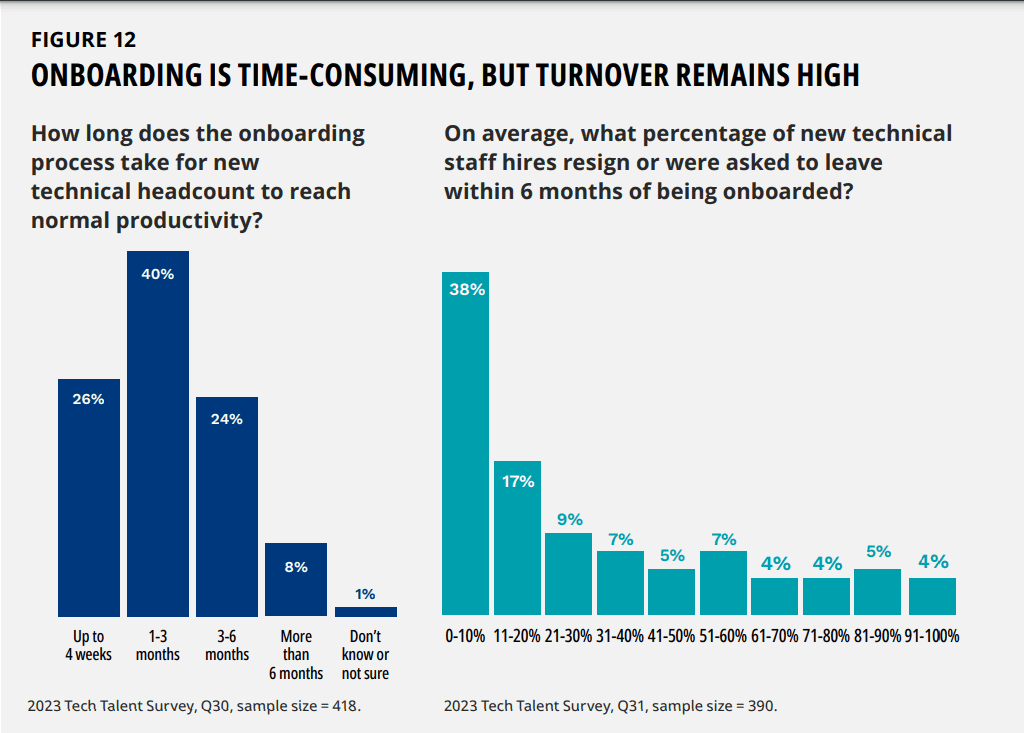
A new survey shows the IT job outlook of 2023 and beyond, some of the biggest challenges in hiring tech talent, and more.
The Linux foundation supports, educates, and encourages new generations of open source innovators. Their open source community conducts a lot of research and surveys to get a clear picture of the IT industry through a unique lens.
Their recent 2023 report provides a lot of interesting insights into what employers are thinking and seeing regarding the job market and outlook.
What Do Employers in the U.S. See as the Biggest IT Hiring Challenges in 2023?
For many employers in the U.S., IT hiring presents several difficult challenges:
- High attrition and turnover rates
- Increased salary costs
- Competitive talent pool
- Economic uncertainty
- A time-consuming process
#1 Hiring is Time-Consuming
Most of the survey respondents showed that it takes between 1-6 months to fill a vacant tech role. About half of respondents said 1-3 months. The average, according to the report, was 4.3 months. This is a hefty amount of time.
The more companies know about the markets they are hiring in, the more efficient their process can be. Companies should find strategies to improve their hiring process to reduce this time of hire without risking bad hires or inaccurate matching.
#2 High Attrition Rates
Attrition rates and turnover rates remain high in the industry. On average 38% of companies suggested that about 0-10% of their new tech hires would resign or be asked to leave within 3 months. In 2019, LinkedIn found that the tech industry had the highest turnover rates at 13.2%.
#3 Onboarding is Lengthy and Requires Resources
For most organizations, the onboarding process takes about 1-3 months. Yet, onboarding is crucial for talent retention. As Forbes reports, the employee’s onboarding experiences can help indicate the success of their long-term relationship with the company.

Other Concerns About Economic Situation
According to the Linux report, the concerns over economic impact for companies’ 2023 technical hiring plans meant that many organizations had to change their plans.
- 44% of companies planned to increase hiring despite the situation
- 34% said they revised their 2023 IT hiring plans to include a hiring freeze

What do some of the changes look like by industry?
As we have seen in the past few years, the digital transformation has touched most industries. Yet, the direction in which technology is heading has not been 100% predictable. New innovations and advancements in AI and machine learning have impacted how industries shift towards a more tech-oriented model.
Each industry has been impacted differently:
- Healthcare, for example, has enough need for technological implementation to require 59% of healthcare-related companies to increase technical staff in 2023
- 65% of cloud service providers or managed service providers have seen increased technical staff in 2023
What Do Companies Project Going Into Late 2023 and 2023?
According to the report’s findings, cautious optimism is in order for most companies. It seems many organizations see the economic situation as one that will correct itself in short order and will therefore allow them to readjust their tech hiring needs.
The survey showed that out of those companies planning to hire in 2023, 46% may be able to hire while 38% plan to hire in 2024. Still about 56% cite the economy as the reason for staff reductions in 2023 and 24.

Struggling to Fill Tech Roles? Look to LATAM Tech Talent
Despite the economic uncertainty, companies still need to fill technical roles that are essential for their growth, stability, and vision roadmaps. The good news about remote work is that companies can now access quality talent across borders without too much hassle.
Ready to take the leap to the bustling LATAM tech ecosystem? Contact our team today.


